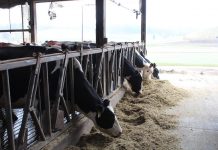“What is holding you back?” A popular statement five years ago when we first addressed this topic in this column.
The seatbelt safety campaign signs can still be found along the roads of rural Ohio urging drivers and passengers to buckle up for their safety. But, if we ask that same question of our dairy businesses, the perspective turns from a safety tool (the belt) to negatively restraining potential of the farm to prosper.
What is holding you back? A good question we should periodically ask ourselves in the context of our lives and our dairy businesses.
Off-the-cuff answers are usually money, time, person x, y or z, time or money. If we take a really honest, thoughtful look we will probably find that we are most frequently what is holding ourselves back.
Attitude
As I talk with people who have left dairy production or dairy service for other industries, a common reflection is the uncommon ability of dairy people to be negative.
I understand how this is an easy habit to slip into. You live where you work, work where you live, work long hours, plans get messed up when some heifer decides to have a giant bull calf Saturday night and you can feel like you are at the mercy of weather and market forces over which you have little or no control.
Wow, that said, go ahead and be a crab. Just kidding. Give it five minutes and get over it.
Allowing yourself to waste time grousing or worrying about things over which you have no control sucks away the opportunity to use that time to think positively about your individual farm or business, pondering actions that allow you to weather the rough spots and move ahead during the good spots.
Willingness to change
Another observation made by former dairy producers and dairy industry types is a general unwillingness to make changes. Many of these same people admit to having suffered from these symptoms themselves, but were so bogged down in the work and prevailing habits that they didn’t realize it at the time.
While we hate to admit it, all businesses do change and must change over time to remain competitive. I think we all have some picture of our ideal dairy farm in our heads and secretly feel that if we finally get this barn built, this tractor or parlor bought, those acres bought or that family member worked in, then we will have the business that will allow us to live happily ever after, no other changes needed.
Whether this picture is realistic or not is an entirely different question.
Change is a fact of life, it is not an indication of failure. Try to think of any business that is exactly the same today as it was when you were a kid.
I have personally made that amusing (I’m trying to be positive here!) but unwelcome discovery that items that were familiar business tools when I was a child, such as the little order cards that home delivery dairies gave their customers to show what dairy products they wanted the milkman to leave are now surfacing at antique shows.
Obviously the “100 years old to be an antique” rule has gone out the window.
Symptoms vs. cause
Frequently, farms know they have a problem. One not uncommon scenario: Herd production hasn’t budged for years.
Half the dairy people in the county can tell you why, but your mantra is that the nutritionist can’t get those cows to produce. No, not one of them can make a decent ration for your cows.
You should know, you’ve tried every one of them in a 50-mile radius.
Thing is, you get two, maybe three cuttings a year of mediocre hay when the guy down the road consistently gets four good cuttings. Of course, the other guy has better equipment, field tile, more help, better cows.
Pick a reason
Cows don’t produce up to their potential and who gets blamed? The nutritionist.
Yep, all of them, the ones that have been encouraging you to do a better job of forage production whether it be preharvest maintenance on equipment in January, not June for the last two years, line up extra help for harvest, haul manure earlier, buy good stuff if you can’t grow it, etc.
But, year after year, the symptom (poor production) is the focus, rather than the fundamental problem, not having good forages as the base of the ration.
This is one example, but there are wide variations of the same story on every farm.
How to kick the habit? There are good people out there. Other dairy producers, your employees, consultants and good Extension people. Use them. Listen to their opinions and ideas and evaluate them with an open mind. What is holding you back?
Dedicate a bit of time to ponder the question. Ask and listen to the thoughts of respected peers. What is holding us back now is likely to be different than what held us back five years ago if we addressed that issue then.
When I click the seatbelt on this week, I’ll be pondering what is holding me back. I challenge you to do the same. What is holding you back?
Then let’s do something about it. Again.
(The author is an OSU Extension dairy specialist located at the extension center in Wooster; 330-263-3799. Send comments or questions in care of Farm and Dairy, P.O. Box 38, Salem, OH 44460.)
STAY INFORMED. SIGN UP!
Up-to-date agriculture news in your inbox!












